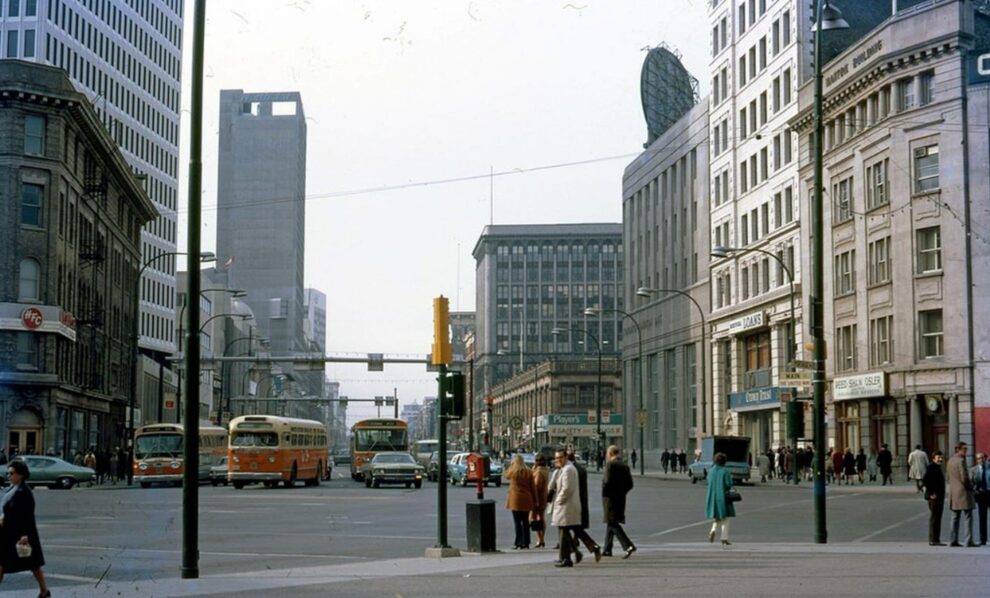Foot traffic, increased connectivity between blossoming downtown districts expected benefit barricade removal
AUTHOR:
Jacques Marcoux
The life of a Winnipegger comes with only three guarantees: spring potholes, mosquitoes, and everyone they know has an opinion on “Portage and Main”.
Sealed off from foot traffic for more than 45 years, the country’s apparently coldest and windiest intersection is now mere months away from re-opening to pedestrians. As we consider what the future holds for this iconic crossing, it’s worth remembering that the motivation for erecting the concrete barricades is identical to the one for tearing them down: A deep desire to breathe new life into Winnipeg’s core.
Out of the story of Portage Avenue and Main Street, emerge lessons for a city seeking urban momentum.
Changing times: urban drain to the suburbs
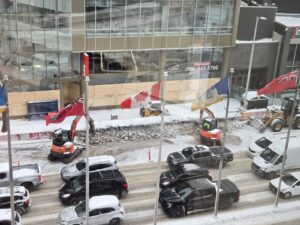
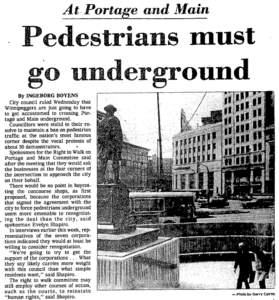
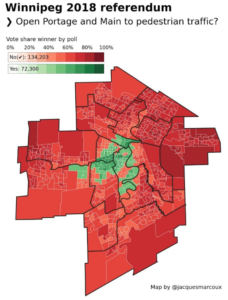
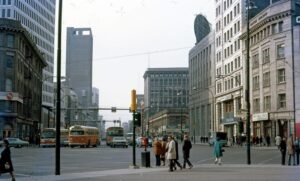
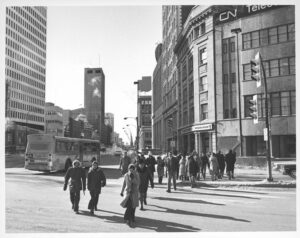
Today’s discourse about the intersection could reasonably lead one to believe the closure was about traffic flows and pedestrian safety. The reality, however, is that a perfect storm of trends and economic pressures began converging years earlier.
“Everyone kind of focuses on that 1979 moment but the downtown already started to hurt in the early sixties,” says Winnipeg-based architectural historian Jeffrey Thorsteinson.
“Portage Avenue was the shopping street from the fifties and sixties […], but the development of suburban shopping centres was pretty intense,” he says.
Thorsteinson says Polo Park Shopping Centre — once upon a time an open-air strip mall — was enclosed in 1966, drawing ever more shoppers. What followed was a cascade of events that altered the city’s DNA.
In 1971, Winnipeg amalgamated with 11 surrounding municipalities, extending the city’s news borders to the far reaches of the suburbs. The construction of shopping centres in St. Vital and Kildonan Place would soon follow.
By now the supremacy of the automobile was well entrenched and Winnipeg’s downtown was spiraling.
Winnipeggers go underground
As macro-economic forces drained the downtown, Winnipeg firm James Richardson & Sons — which had just recently completed the construction of their 34-story headquarters on the North-East corner of the intersection — hatched a plan to build its own underground shopping area.
Thorsteinson’s deep dive into municipal records at the time found that shortly after, the underground concept expanded, this time looping in Montreal developers Trizec and city officials. Montréal modernist city planner Vincent Ponte, a resolute proponent of ultra-modern multi-level metropolis designs, was hired to come up with an intersection-wide plan.
By 1976, all parties came to an agreement and construction began. The deal included a promise to barricade the intersection, redirect foot traffic underground for no less than 40 years.
Thorsteinson’s research suggests public opposition to the closure didn’t enter the collective psyche until the last moment, when a number of groups staged protests in vain.
The underground concourse was officially opened on February 23, 1979. Two months later, the city outlawed street-level crossing, according to Winnipeg Free Press coverage at the time.
All is quiet on Portage and Main
As the city moved on from the debate, it was clear the underground concourse was not a silver bullet for urban decay. In response, a new plan emerged.
Backed by a tri-level agreement between the governments of Canada, Manitoba and the City of Winnipeg, the Winnipeg Core Area Initiative was hatched. Records show $196 million dollars was poured into Winnipeg’s core over a decade, spawning development such as Portage Portage Place Mall — a project that failed to live up to its early hype.
But as time went on, Portage and Main inconspicuously continued to ingrain itself in the city’s local lore. In 1981, Dale Hawerchuk signed his contract with the Winnipeg Jets. In 1992, Randy Bachman released “Prairie Town”, a song featuring Neil Young with the refrain “Portage and Main, 50 below”. Then in 1995, several Save The Jets rallies were held at the intersection.
Meanwhile Winnipeggers continued to navigate the concrete maze beneath the famed crossing, only to continue retreating to the suburbs after hours.
An intersection election
For several Winnipeg mayors, chiming in the future of the intersection practically became a pastime. Glen Murray flirted with the idea of reopening the crossing on a number of occasions. Fresh off his election victory in 2004, Sam Katz, however, made clear the barricades were not coming down.
After a decade in office, Katz announced he would not seek reelection in the 2014 municipal elections, setting the stage for a wide open race. With seven candidates in the running, eventual winner Brian Bowman Tweeted a campaign promise that re-ignited the debate over the intersection’s closure.
“If elected mayor, I pledge to re-open barriers to pedestrians,” he Tweeted in August 2014.
In the weeks leading up to the 2018 civic election, city council voted in favour of adding a now infamous non-binding plebiscite question on the ballot: To open the intersection, or not.
Bowman, now the incumbent, saw his main mayoral rival Jenny Motkaluk quickly capitalize on the moment to firmly stake her entire campaign on this single issue, taking the opposing view from Bowman on the intersection. By a large margin, suburban Winnipeggers voiced a desire to keep it shut.
Ironically, the latest traffic study shows there are five intersections that allow pedestrian traffic with busier motor-vehicle traffic levels.
But in the end, the deciding factor for the reopening was the expiry of the 40-year closure agreement and new engineering reports that found more than $73 million in repairs would be needed to keep the underground concourse open.
In March 2024, city council voted to open Portage Avenue and Main Street to pedestrians.
Human traffic needed to turn the tide
When the intersection was closed in 1979, the city’s lead planner at the time, Earl Levin, stated that a dramatic increase in downtown residential density was a necessary complement – by his estimates, 100 thousand people should be the goal.
“A large resident population would guarantee the flow of investment,” he said at a 1968 luncheon, according to the Winnipeg Free Press.
Today, the view is much the same.
“You know, the one thing that I hope that we begin to see is just people,” says Jino Distasio, Director of the Institute of Urban Studies at the University of Winnipeg.
“I don’t really foresee a whole lot of dramatic change, but what I do expect to see is some real subtle differences in just the visibility of people and intensity of people,” he says.
Distasio, believe one of the most likely benefits to opening the intersection is the network continuity it will create between downtown zones that have been successful in rebuilding like the Exchange District, True North Square and the new 300 Main Street residential high-rise.
Loren Remillard, President and CEO of the Winnipeg Chamber of Commerce, echoes the same views as Distasio.
“Every city that has turned the tide on its decline or has seen its vibrancy grow, it’s because of activity – human traffic, human activity,” he says.
The Chamber, which just a year ago relocated their headquarters directly on the South-West side of Portage and Main, says they are pleased with the prospect for increased pedestrian activity, but says there’s also a desire by the business community to maintain a dual track, with traffic underground.
“The connectivity in the underground concourse provides a key feature for employees working in these towers,” says Remillard. “There’s a lot of foot traffic that moves between the towers through the professional service firms, and others located throughout.”
At the end of the day, Remillard quips he’s just looking forward to seeing the city move onwards and upwards.
“You know, I look forward to never hearing another media story of a visiting dignitary or celebrities that gets lost trying to cross a street in Winnipeg. If that’s our only win from this, then it’s a victory for us all.”
-30-



